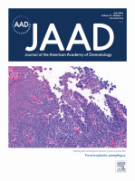?- and ?-Papillomavirus infection in a young patient with an unclassified primary T-cell immunodeficiency and multiple mucosal and cutaneous lesions - 18/06/14

Abstract |
Background |
Correlating human papillomavirus (HPV) type with the clinical and histopathological features of skin lesions (from genital and nongenital sites) can present a diagnostic challenge.
Objective |
In this study, HPV infection patterns were correlated with pathology and clinical presentation in lesional and nonlesional body sites from a young patient with a primary T-cell immunodeficiency.
Methods |
HPV infection was evaluated at both DNA and protein levels by polymerase chain reaction and immunohistochemistry.
Results |
The patient’s genital lesions were caused exclusively by α-genotypes (high-risk type HPV-51 in the anal and low-risk type HPV-72 in the penile condylomas). The opposite was true for the skin lesions, which were infected by β-genotypes alone (HPV-8 and HPV-24). HPV-24 was the predominant type in terms of viral load, and the only one found in productive areas of infection. The patient had already developed high-grade dysplasia in the anal condyloma-like lesions, and showed areas of early-stage dysplasia in the lesions caused by the β-genotype HPV-24.
Limitations |
The basic origin of the immunodeficiency is not yet defined.
Conclusion |
These findings provide proof of principle that both α- and β-genotypes can cause overt dysplastic lesions when immunosurveillance is lost, which is not restricted to epidermodysplasia verruciformis.
Le texte complet de cet article est disponible en PDF.Key words : papillomavirus, primary immunodeficiency, skin cancer, viral carcinogenesis, viral life cycle
Abbreviations used : EV, FISH, HPV, MCM7, PCR, PID, WHIM
Plan
| Supported by grants from Compagnia di San Paolo (CSP2012 to Dr Gariglio) and Associazione Italiana per la Ricerca sul Cancro (IG 2012 to Dr Gariglio), ESCMID Research Grant 2013 (ESCMID 2013 to Dr Borgogna), and the Ministry of Education, University and Research (FIRB 2008 to Dr De Andrea). “Fondazione Banca Popolare di Novara per il territorio” contributed toward purchasing the digital scanner Pannoramic MIDI, Histec Budapest, Hungary. The PhD fellowship of Dr Peretti is funded by “Fondazione Franca Capurro per Novara Onlus.” |
|
| Conflicts of interest: None declared. |
|
| Reprints not available from the authors. |
Vol 71 - N° 1
P. 108 - juillet 2014 Retour au numéroBienvenue sur EM-consulte, la référence des professionnels de santé.
L’accès au texte intégral de cet article nécessite un abonnement.
Déjà abonné à cette revue ?

